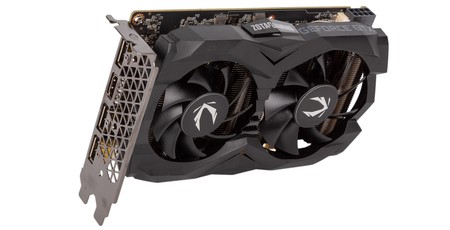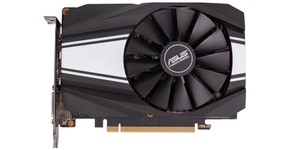
Performance Analysis
Although you won’t notice a difference between them, our benchmarks do tease out a consistent performance difference between this Zotac card and Palit’s StormX one, with the latter being about 2.5 percent faster on average. Whereas Zotac’s boosts to 1,770MHz or so, we saw Palit more consistently reaching 1,845MHz, which is a fairly substantial difference in boost behaviour for two cards with the same clocks. Zotac’s card does run a little hotter, but it could also be Palit’s card having more power budget available as a result of more efficient components (even having one fewer fan might help slightly).
Offering 29 percent more performance than a GTX 1060 6GB within the same power envelope, this card is clearly efficient but maybe not as fast as many would hope given how old GTX 1060 is. We don’t reckon it’s worth upgrading from one to the other, but that may not be the case for older cards; you can use our 3DMark results to compare your own hardware to for a rough estimation of the sort of upgrade you’d be likely to see.
A couple of things have happened since our original GTX 1660 Ti review, namely GTX 1660 and even more aggressive AMD pricing. With the former card starting at £200, GTX 1660 Ti’s position in Nvidia’s own stack looks precarious. The card in our graphs is an OC version, which closes the gap, but we know from testing stock-clocked GTX 1660s for upcoming reviews that this Zotac GTX 1660 Ti only offers about 14 percent more performance – pretty poor when the price is 30 percent higher. You do get much faster GDDR6 memory on GTX 1660 Ti, but this rarely gives it a clear advantage even at 1440p. On the other side, RTX 2060 scales pretty well with 23 percent more performance.

As for AMD, RX 590 isn’t much of a threat to this card at £235, but RX 580 is pretty compelling at £180. Zotac is still a full 25 percent faster overall here, but you’d ideally want to see even more performance or a lower price. Similarly, Radeon RX Vega 56 can be found in decent SKUs for £280 and is 15 percent ahead overall. These average comparison are of course useful at a glance, but they do disguise larger differences that vary from game to game. For instance, in Total War: Warhammer II (where Nvidia’s minimums are all over the place), average FPS on Vega 56 is 66fps compared to just 50fps on this GTX 1660 Ti, but in Wolfenstein and Battlefield 1 there is closer performance between the two.
You might also expect AMD’s larger memory (8GB even at RX 580 level) to help at 1440p, but overall there is no pattern in our benchmarks to indicate this. Fire Strike Extreme, a 4K synthetic test, does see GTX 1660 Ti performance crash hard, but the 4K Time Spy test does not, so even this is inconclusive.
One good thing about the Zotac card is that it is very, very quiet. We measured peak fan speeds of around 1,600 RPM and could barely hear it at all. Its quieter than Palit’s offering, but temperatures are a touch higher. Power consumption is identical, which is not surprising, and it’s far below both RX 590 and RX Vega 56; this is an area where AMD has catching up to do.
Overclocked, we got 8-10 percent more performance while observing only small increases in temperature and fan speed. However, Palit’s card was boosting to around 2GHz whereas here it was again about 50MHz slower despite the clocks being nominally the same. Practically there’ll be no difference, but this did see Palit get marginally higher frame rates in Wolfenstein II and Battlefield 1.
Conclusion
There are always a lot of factors to consider when choosing a graphics card in the middle of the pack, but in this instance we’re not convinced the Zotac GTX 1660 Ti has enough going for it.

Aggressive pricing from AMD is certainly one factor, although if you prioritise efficiency and low noise the red team’s hardware will have less appeal. AMD also doesn’t hold its FreeSync advantage quite so well now, but its cards do come with two or three free games whereas GTX 1660 Ti has none. The GeForce and Radeon software ecosystems are also worth considering, especially if you are into streaming, but these are beyond the scope of this performance review.
GTX 1660 pricing is the real kicker, however. At £200, it makes the £260 asked for here look too expensive, and it’s possible Nvidia is keeping it at this level so as to keep RTX 2060 looking strong. At £230-£240, stock-clocked GTX 1660 Ti would make more sense, but then RTX 2060 looks like even worse value.
There isn’t much Zotac can do about this, of course, and it’s basic card design has no major flaws, but even if you are settled on GTX 1660 Ti purely from wanting Nvidia’s best current-gen non-RTX card, Palit’s higher boosting and lower temperature makes it a better choice, while overclocked variants are also available for the same price.

MSI MPG Velox 100R Chassis Review
October 14 2021 | 15:04








Want to comment? Please log in.